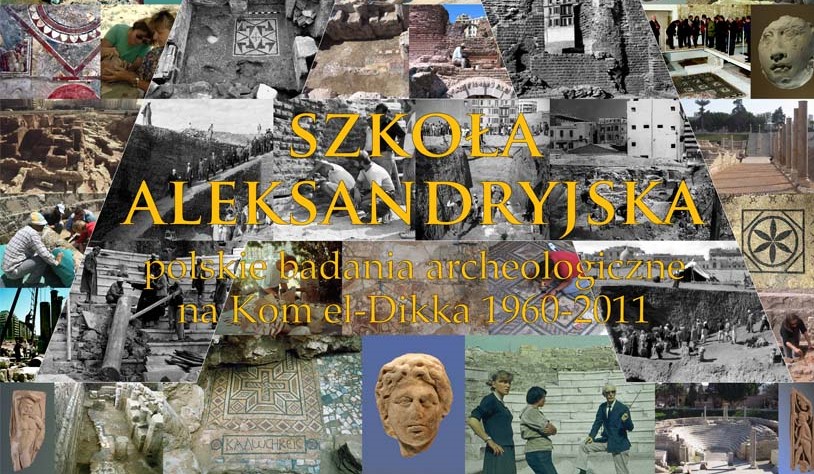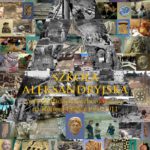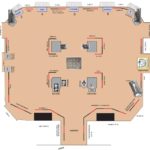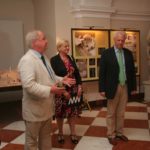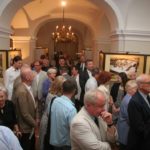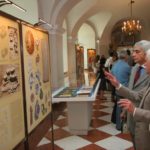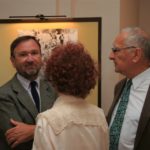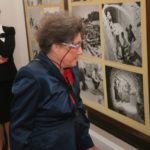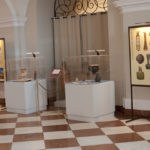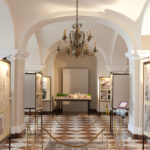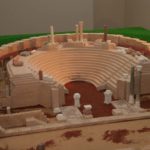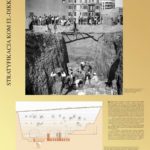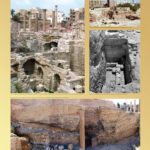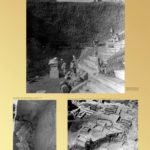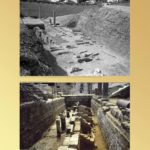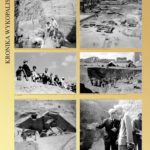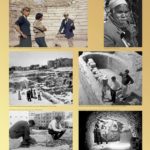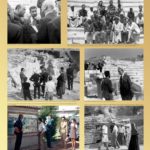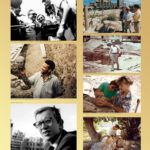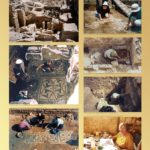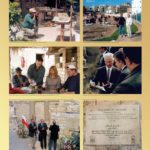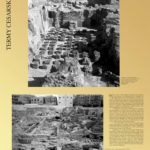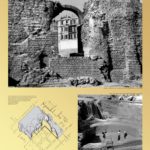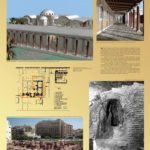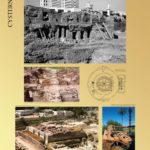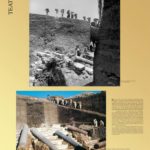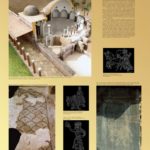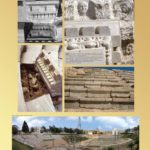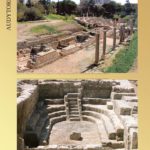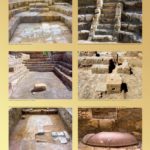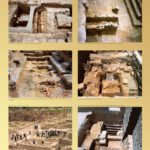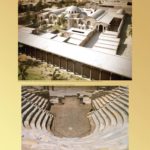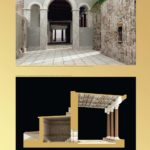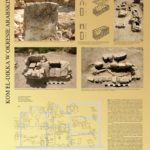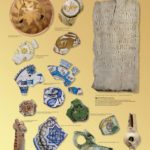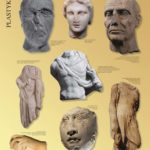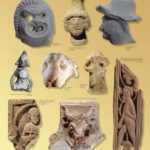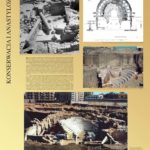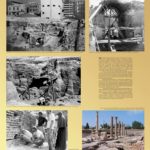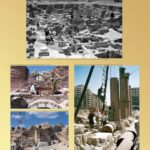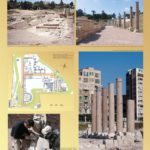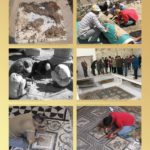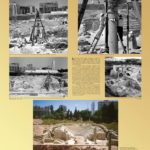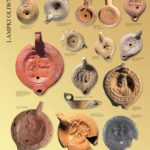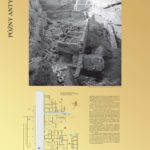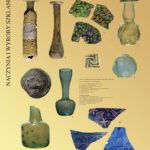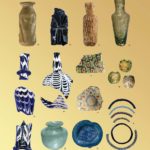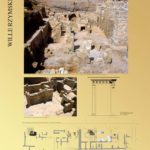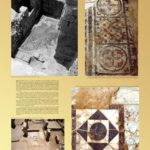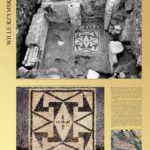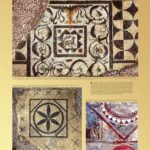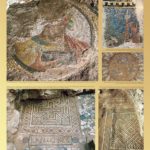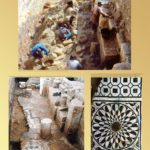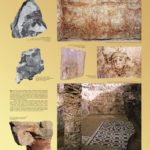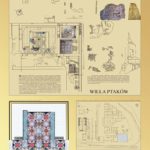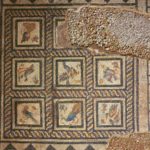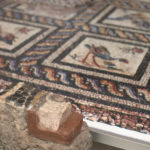We are presenting the digital version of the exhibition “The Alexandrian School” prepared in 2012 to mark the 50th anniversary of Polish archaeological research in Alexandria. The exhibition was displayed at the Royal Castle in Warsaw. It showcased the achievements of archaeologists working since 1960 with the PCMA UW expedition at the site of Kom el-Dikka.
This site, located in the center of the modern city of Alexandria, is the only area of this size (approx. 4 ha) in the ancient metropolis – the capital of Ptolemaic Egypt – systematically investigated by archaeologists. Over the past five decades, the entire downtown quarter of ancient Alexandria has been uncovered and explored, including a unique theater with its dazzling marble auditorium, a complex of late Roman imperial baths and cisterns, as well as the Alexandrian Academy’s lecture hall complex, and a series of villas with figural and geometric mosaic floors.
The results of these explorations and the finds were presented at the exhibition on photographic boards accompanied by some artifacts from the period. They showed the most important stages of the archaeological research, as well as the extent of the conservation work that was carried out parallel with the excavations. This combination resulted in the creation of a unique archaeological park, with restored ancient public buildings, a residential quarter, columned porticos, and passages.
The title of the exhibition is a reference to the term “Polish school of Mediterranean archaeology”, a term coined to describe the legacy of Professor Kazimierz Michałowski, who gave rise to the existence of this field of research in Poland. Alexandria was, and remains, its flagship site. During half a century of excavations, it served as a training ground for several generations of Polish researchers. But the title also refers to the 22 lecture halls discovered at Kom el-Dikka, the so-called auditoria that, together with the amphitheater-odeon rebuilt in the 6th century into an auditorium, formed the academic complex of late ancient Alexandria.
This unique architectural complex is a material testimony to the continuation of the tradition of the famous Alexandrian school, known e.g. from achievements in the field of rhetoric, law, and philosophy (including Philo, Hypatia, Klemens). So far, it is the only academic complex discovered by archaeologists in the entire Mediterranean basin, although similar institutions must have functioned in other parts of the ancient world.
Read more on the PCMA UW research at Kom el-Dikka
Book accompanying the exhibition (in Polish): Wojciech Kołątaj, Renata Kucharczyk, Grzegorz Majcherek, Franciszek Pawlicki, Starożytna Aleksandria. 50 lat polskich badań archeologicznych i prac konserwatorskich na Kom el-Dikka, Warszawa: PCMA, 2012
Exhibition: „Szkoła Aleksandryjska. 50 lat polskich badań archeologicznych i prac konserwatorskich na Kom el-Dikka”
Partners: Polish Centre of Mediterranean Archaeology of the University of Warsaw, Royal Castle in Warsaw, National Museum in Warsaw.
Exhibition curator: Dr Franciszek Pawlicki (PCMA UW).
Plates: PCMA UW. Theatre model: Piotr Zambrzycki. Artifacts: 29 objects from the Collection of Ancient and Eastern Christian Art and 44 coins from the Department of Coins and Medals, 16 objects from the Collection of Oriental Art, all of the National Museum in Warsaw; herma of Alexander the Great (a gypsum copy of a bust by Lysipus) by Łazienki Królewskie Museum in Warsaw.
Exhibition folder: text A. Twardecki (NMW), phoptos Z. Doliński (NMW), design F. Pawlicki, DTP P. Zakrzewski.
-
1. Plakat wystawy “Szkoła Aleksandryjska” // Poster for the exhibion “The Alexandrine School”.
-
2. Zaproszenie na wystawę – awers // Invitation to the exhibition.
-
3. Plan ekspozycji w Sali Skarbca na Zamku Królewskim w Warszawie // Plan of the exhibition in the Treasury of the Royal Castle in Warsaw.
-
4. Otwarcie wystawy: od lewej, dr Przemysław Mrozowski – dyr. Zamku Królewskiego w Warszawie, dr Agnieszka Morawińska – dyr. Muzeum Narodowego w Warszawie, prof. dr hab. Piotr Bieliński – dyr. CAŚ UW // Opening of the exhibition: from the left, Dr Przemysław Mrozowski – Director of the Royal Castle in Warsaw, Dr Agnieszka Morawińska – Director of the National Museum in Warsaw, Prof Piotr Bieliński – Director of the PCMA UW.
-
5. Otwarcie wystawy – zaproszeni goście // Opening of the exhibition – invited guests.
-
6. Ambasador Egiptu zwiedzający wystawę // The Ambassador of Egypt visiting the exhibition.
-
7. Otwarcie wystawy: kierownik badań w Aleksandrii, dr Grzegorz Majcherek i prof. Michał Gawlikowski // Opening of the exhibition: director of the expedition in Alexandria, Dr. Grzegorz Majcherek and prof. Michał Gaalikowski
-
8. Otwarcie wystawy: Kierowniczka biura CAŚ UW, Krystyna Polaczek zwiedza wystawę // Opening of the exhibition: The long-time head of the PCMA UW office in Warsaw, Krystyna Polaczek, visits the exhibition
-
9. Fragment ekspozycji: gabloty z ceramiką i terakotami // Fragment of the exhibition: cases with pottery and terracottas.
-
10. Fragment ekspozycji: plansza z mozaiką z przedstawieniem ptaków po środku sali i makieta budowli teatralnej w głębi // Fragment of the exhibition: plate with a floor mosaic depicting birds in the middle of the room and a scale model of the theatre in the background.
-
11. Makieta budowli teatralnej odkrytej na Kom el-Dikka // Model of the theater building discovered at Kom el-Dikka.
-
12. Plansza: Stratyfikacja Kom el-Dikka 1 // Plate: stratification of Kom el-Dikka 1.
-
13. Plansza: Stratyfikacja Kom el-Dikka 2 // Plate: stratification of Kom el-Dikka 2.
-
14. Plansza: Stratyfikacja Kom el-Dikka 3 // Plate: stratification of Kom el-Dikka 3.
-
15. Plansza: Stratyfikacja Kom el-Dikka 4 // Plate: stratification of Kom el-Dikka 4.
-
16. Plansza: Kronika polskich wykopalisk na Kom el-Dikka 1 // Plate: Chronicle of Polish excavations at Kom el-Dikka 1.
-
17. Plansza: Kronika polskich wykopalisk na Kom el-Dikka 2 // Plate: Chronicle of Polish excavations at Kom el-Dikka 2.
-
18. Plansza: Kronika polskich wykopalisk na Kom el-Dikka 3 // Plate: Chronicle of Polish excavations at Kom el-Dikka 3.
-
19. Plansza: Kronika polskich wykopalisk na Kom el-Dikka 4 // Plate: Chronicle of Polish excavations at Kom el-Dikka 4.
-
20. Plansza: Kronika polskich wykopalisk na Kom el-Dikka 5 // Plate: Chronicle of Polish excavations at Kom el-Dikka 5.
-
21. Plansza: Kronika polskich wykopalisk na Kom el-Dikka 6 // Plate: Chronicle of Polish excavations at Kom el-Dikka 6.
-
22. Plansza: Termy cesarskie 1 // Plate: Imperial Baths 1.
-
23. Plansza: Termy cesarskie 2 // Plate: Imperial Baths 2.
-
24. Plansza: Termy cesarskie 3 // Plate: Imperial Baths 3.
-
25. Plansza: Cysterna // Plate: water cistern.
-
26. Plansza: teatr 1 // Plate: the theater 1.
-
27. Plansza: teatr 2 // Plate: the theater 2.
-
28. Plansza: teatr 3 // Plate: the theater 3.
-
29. Plansza: teatr 4 // Plate: the theater 4.
-
30. Plansza: Audytoria 1 // Plate: the auditoria 1.
-
31. Plansza: Audytoria 3 // Plate: the auditoria 3.
-
32. Plansza: Audytoria 4 // Plate: the auditoria 4.
-
33. Plansza: Audytoria 5 // Plate: the auditoria 5.
-
34. Plansza: Audytoria 6 // Plate: the auditoria 6.
-
35. Plansza: Kom el-Dikka w okresie arabskim 1 // Plate: Kom el-Dikka in the Arab period 1.
-
36. Plansza: Kom el-Dikka w okresie arabskim 2 // Plate: Kom el-Dikka in the Arab period 2.
-
37. Plansza: Plastyka 1 // Plate: Sculpture 1.
-
38. Plansza: Plastyka 2 // Plate: Sculpture 2.
-
39. Plansza: Plastyka 3 // Plate: Sculpture 3.
-
40. Plansza: Konserwacja i anastyloza 1 // Plate: Conservation and anastylosis 1.
-
41. Plansza: Konserwacja i anastyloza 2 // Plate: Conservation and anastylosis 2.
-
42. Plansza: Konserwacja i anastyloza 3 // Plate: Conservation and anastylosis 3.
-
43. Plansza: Konserwacja i anastyloza 4 // Plate: Conservation and anastylosis 4.
-
44. Plansza: Konserwacja i anastyloza 5 // Plate: Conservation and anastylosis 5.
-
45. Plansza: Konserwacja i anastyloza 6 // Plate: Conservation and anastylosis 6.
-
46. Plansza: Lampki oliwne // Plate: Oil lamps.
-
47. Plansza: Późny Antyk 1 // Plate: Late Antiquity 1.
-
48. Plansza: Wyroby szklane 1 // Plate: Glass ware 1.
-
49. Plansza: Wyroby szklane 2 // Plate: Glass ware 2.
-
50. Plansza: Wille rzymskie 1 // Plate: Roman villas 1.
-
51. Plansza: Wille rzymskie 2 // Plate: Roman villas 2.
-
52. Plansza: Wille rzymskie 3 // Plate: Roman villas 3.
-
53. Plansza: Wille rzymskie 4 // Plate: Roman villas 4.
-
54. Plansza: Wille rzymskie 5 // Plate: Roman villas 5.
-
55. Plansza: Wille rzymskie 6 // Plate: Roman villas 6.
-
56. Plansza: Wille rzymskie 7 // Plate: Roman villas 7.
-
57 Plansza: Wille rzymskie – Willa Ptaków // Plate: Roman villas – Villa of the Birds.
-
58. Willa Ptaków – mozaika antyczna zdobiąca posadzkę w sypialni // Villa of the Birds – floor mosaic from the bedroom.
-
59. Przekrój stratygraficzny podłoża mozaiki // Stratigraphic section of the mosaic bedding layers.

